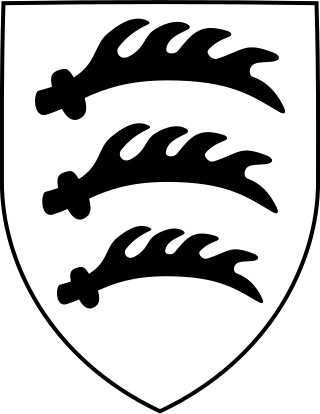The 10th Infantry Division was created in October 1934 under the cover name Wehrgauleitung Regensburg to hide its violation of the Treaty of Versailles. It was renamed the 10th Infantry Division when the establishment of the Wehrmacht was announced publicly in October 1935.
The 1st Infantry Division was an infantry division that notably served in World War II as part of the Heer of Nazi Germany's Wehrmacht. It had been one of the original infantry divisions of the Reichswehr.

The German 23rd Infantry Division, later the 26th Panzer Division, was a military unit operational during World War II. It was organized along standard lines for a German infantry division. It was non-motorised and relied on horse-drawn wagons for its mobility. The unit carried the nickname Grenadierkopf.

The 4th Infantry Division, designated 4.Infanterie-Division in German was one of the first divisions raised and served during part of World War II. In 1940 it was reorganized as 14th Panzer Division.

The 16th Infantry Division of the German Army was formed in 1934. On 26 August 1939 the division was mobilized for the invasion of Poland (1939). It participated in the Battle of France in August 1940. The division was then split, resulting in two independent units: The 16th Panzer Division and the 16th Motorized Infantry Division. Then later, from 1944 onward, combined with other non 16th elements, was known as the 116th Panzer Division.

The 29th Infantry Division was a unit of the German army created in the fall of 1936. It was based on the old Reichswehr 15th Infantry Regiment and drew its initial recruits from Thuringia. It was upgraded to 29th Motorized Infantry Division in the fall of 1937. The division was also known as the Falke-Division.

The 12th Panzer Division was an armoured division in the German Army, established in 1940.

The German 20th Infantry Division was an infantry division of Nazi Germany.

The 3rd Infantry Division was an infantry division of the German Army that fought in World War II. The division was established under the cover name Wehrgauleitung Frankfurt in 1934 by expanding the 3rd Division of the Reichswehr. It was redesignated Kommandant von Frankfurt shortly afterward, and took on its bona fide name when the formation of the Wehrmacht was announced in October 1935. In March 1939 the division took part in the invasion and occupation of Czechoslovakia.
The 18th Infantry Division was formed on 1 October 1934 as Infantry Command III in Liegnitz and renamed the 18th Infantry Division on 15 October 1935. Mobilized in August 1939, it participated in the Invasion of Poland and in 1940 in the Battle of France. After the French campaign, the division was motorized and redesignated 18th Motorized Infantry Division on 1 November 1940 serving on the Eastern Front for the remainder of the war. In June 1943, the division was redesignated 18th Panzergrenadier Division.

The German 5th Infantry Division was formed in October 1934 and mobilized on 25 August 1939. The division's troops were garrisoned in Konstanz, Ulm, and Freiburg. When formed, the division consisted of the 1st, 2nd, and 3rd battalions of the 14th, 56th, and 75th Infantry Regiments, the 1st, 2nd, and 3rd Battalions of the 5th Artillery Regiment, the 1st battalion of the 41st Artillery Regiment, and assorted 5th Division support units.
The 19th Panzer Division was an armoured division in the German Army, the Wehrmacht, during World War II. It was created from the 19th Infantry Division.
The 21st Infantry Division was a German military unit which fought during World War II.

The 14th Infantry Division was a formation of the Germany Army (Wehrmacht) which fought during World War II.

The 25th Infantry Division was a military unit of the German Wehrmacht. It was later reclassified to 25th Motorized Infantry Division, and in June 1943 to the 25th Panzergrenadier Division.

The 30th Infantry Division of the Wehrmacht was created on 1 October 1936 in Lübeck and mobilized on 26 August 1939 for the upcoming invasion of Poland. At that time, it consisted of the usual German infantry division elements: three infantry regiments of three battalions each, one three-battalion regiment of light artillery, one battalion of heavy artillery, a panzerjager (anti-tank) battalion, an aufklärungs (reconnaissance) battalion, a signals battalion, a pioneer (engineer) battalion, and divisional supply, medical, and administrative units.
The 7th Infantry Division was a formation of the German Wehrmacht during World War II.

The 9th Infantry Division was a formation of Nazi Germany's Wehrmacht.

The 11th Infantry Division was an infantry division of the Wehrmacht that was initially founded as a cover formation during the Reichswehr era. It was active from 1934 to 1945.

The 2nd Infantry Division of Nazi Germany's Army was created from components of the Reichswehr's old 2nd Division in 1934, at first under the cover name Wehrgauleitung Stettin and later Artillerieführer II; it did not take its real name until October 1935. It was upgraded to 2nd Motorized Infantry Division in 1937, and fought under that name in Heinz Guderian's XIX Corps during the 1939 Invasion of Poland, first in the cut across the Polish Corridor to reach East Prussia and then as support for the push on Brest-Litovsk. It was then transferred to the west, where it took part in the 1940 Battle of France.














